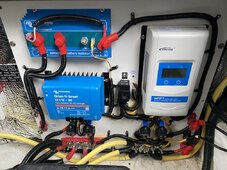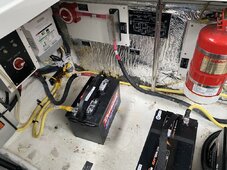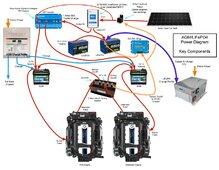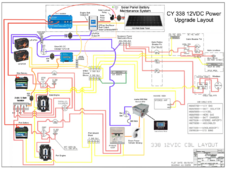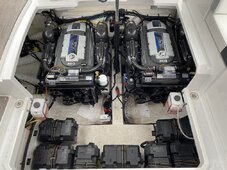tpenfield
New Member
Greetings,
I'm new to the forum and looking for some guidance. I have a twin engine boat that has a fairly complex electrical system and has 7 AGM batteries divided into 3 banks (originally it was 4 banks, but I joined 3 & 4 into a single bank). I added a 100 watt Renogy solar charging system with a 10 amp Voyager controller feeding into a Victron ArgoFET 3 bank isolator. The system has worked well in maintaining the batteries, as the boat sits on a mooring away from shore power when not in use. The boat was made in 2015 and the batteries (original) are at their end of life (~ 9 years).
My plan is to re-design the electrical power system to have 2 AGM batteries (one of each engine) and 2 LiFePO4 batteries (100Ah) to supply the house & 2000 watt inverter (Xantrex SW2012). The engine alternators are rated at 70 amp and feed into a 2 alternator/3 bank isolator.
My design challenge has been to come up with a system that can charge/maintain the batteries via solar when the boat is not in use and then rely on the alternators for charging when the engines are running, and shore power when the boat is at a slip for overnights. I also have a ProNautic 1230 shore power charger when the boat is at a slip (occasional overnights). When on shore power, both the ProNautic and the Xantrex can charge batteries.
I'm fairly new to the details of lithium battery technology, but have learned the basics. After some guidance from several electrical engineering types, I have come up with the following schematic . . .
Looking for comments and guidance. . . . will it work? If not what changes may be advised to make things work (work better). Thanks in Advance . . .
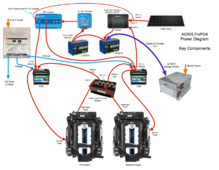
I'm new to the forum and looking for some guidance. I have a twin engine boat that has a fairly complex electrical system and has 7 AGM batteries divided into 3 banks (originally it was 4 banks, but I joined 3 & 4 into a single bank). I added a 100 watt Renogy solar charging system with a 10 amp Voyager controller feeding into a Victron ArgoFET 3 bank isolator. The system has worked well in maintaining the batteries, as the boat sits on a mooring away from shore power when not in use. The boat was made in 2015 and the batteries (original) are at their end of life (~ 9 years).
My plan is to re-design the electrical power system to have 2 AGM batteries (one of each engine) and 2 LiFePO4 batteries (100Ah) to supply the house & 2000 watt inverter (Xantrex SW2012). The engine alternators are rated at 70 amp and feed into a 2 alternator/3 bank isolator.
My design challenge has been to come up with a system that can charge/maintain the batteries via solar when the boat is not in use and then rely on the alternators for charging when the engines are running, and shore power when the boat is at a slip for overnights. I also have a ProNautic 1230 shore power charger when the boat is at a slip (occasional overnights). When on shore power, both the ProNautic and the Xantrex can charge batteries.
I'm fairly new to the details of lithium battery technology, but have learned the basics. After some guidance from several electrical engineering types, I have come up with the following schematic . . .
Looking for comments and guidance. . . . will it work? If not what changes may be advised to make things work (work better). Thanks in Advance . . .




